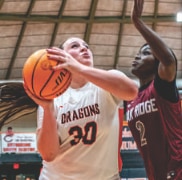The Shepherd of the Hills
From the Mountains

They generally gathered herbs when they were in full bloom as they felt the medicinal value was more potent at that time. Early settlers learned from the Indians and from experimentation because there was an acute shortage of medical doctors in the pioneer settlements and sparsely settled mountain areas.
Those who took up doctoring in these isolated areas became known as herb doctors. They would make medicine from leaves, stems, roots and flowers from plants that mostly grew wild.
These herb doctors generally believed that there was a plant for every disease.
The medicine they concocted was called bitters, probably because it tasted that way.
Many mountaineer families mistrusted trained doctors as they mistrusted most “outsiders.” This prolonged the trade of herb doctoring in isolated mountain areas.
Rev. J. J. DeWall was the first superintendent of the Red Bird Settlement School. He found an urgent need for a medical doctor when he arrived in northern Bell County, Kentucky, in 1921.
Bell County is located in southeast Kentucky and adjoins Claiborne County, Tennessee, in which Cumberland Gap is located.
It was difficult to get a doctor for the area initially, but he was able to get a full-time nurse, Miss Lydia B. Rice.
She traveled about the region astride her horse, Major, caring for the sick and injured and teaching mountain mothers the importance of cleanliness and care for their infants.
A modern school building with six classrooms and a large auditorium was erected on the Beverly campus in 1926, and the enrollment quickly swelled from 50 to 205 pupils.
Resident students came from eight area counties.
DeWall was a forerunner in vocational education. He felt mountain schools should teach vocational skills in addition to book learning.
It was his desire for the boys to learn carpentry, cabinetmaking and blacksmithing, and girls to learn cooking, sewing and weaving.
The need was partially met with the girls’ on-the-job training in the dormitory and kitchen and by the boys working in the garden and stable.
In February 1927, DeWall was successful in acquiring the services of a doctor for the area. Dr. Harlan S. Heim arrived after working two years at Bellevue Hospital in New York City.
He and his mule, Adam, served a wide area in the mountains of southwest Kentucky.
DeWall was concerned that Dr. Heim would not like the area because it was isolated and the people tended to shy away from outsiders.
He need not have worried, as Dr. Heim learned to love the Kentucky mountains and her people.
“These people have a great heritage,” Dr. Heim wrote.
“But since their coming to America, the rest of the country has gone on about their progress and prosperity and they have forgotten these children of the mountains. I am mightily glad to be associated with a work that looks toward giving these people a greater opportunity.”
A church was also built in 1927. It was constructed from native timber with the labor of many local men including Rev. DeWall.
A hospital was built the following year and was located at the junction of the two branches of Red Bird Creek.
A catastrophe came to the school, however, when Rev. DeWall was in an accident while assisting with the construction of the hospital.
He passed away on September 23, 1928, at age 42.
He accomplished much in his seven years at the school, securing 100 acres and supervising and assisting in the construction of 12 buildings.
He directed the religious and social work of the school, and taught in the high school.
He also assisted the nurse and doctor in caring for the injured and ill.
DeWall, “the Shepherd of the Hills,” was lamented as being a friend to every boy, girl, man and woman in the mountains.
He is buried on the hillside near the old Red Bird Methodist Church on the original Settlement School grounds.
Copyright 2023 Jadon Gibson.
Jadon Gibson is a freelance writer from Harrogate.
His writings are both historic and nostalgic in nature.
If you like his stories, tell others as they may like them, too.
Thanks to Lincoln Memorial University, Alice Lloyd College and the Museum of Appalachia. for their assistance.

